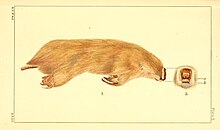Notoryctidae
| Marsupial moles Temporal range: 20–0 Ma Miocene to Recent |
|
|---|---|
 |
|
| Scientific classification | |
| Kingdom: | Animalia |
| Phylum: | Chordata |
| Class: | Mammalia |
| Infraclass: | Marsupialia |
| Superorder: | Australidelphia |
| Order: |
Notoryctemorphia Kirsch, in Hunsaker, 1977 |
| Family: |
Notoryctidae Ogilby, 1892 |
| Genus: |
Notoryctes Stirling, 1891 |
| Species | |
 |
|
| Ranges of marsupial mole species | |
Marsupial moles (Marsupialia, Australidelphia, Notoryctidae) are specialized marsupial mammals, known from two species distributed in the Australian interior.
Notoryctids are small, fossorial mammals that anatomically converge on other fossorial (and distantly related) mammals, such as living golden moles (Chrysochloridae) and extinct epoicotheres (Pholidota).
Like chrysochlorids and epoicotheres, notoryctids utilize their forelimbs and enlarged central claws to dig in a parasagittal (i.e., up and down) plane, as opposed to the "lateral scratch" style of digging that characterizes talpid moles. Marsupial moles spend most of their time underground, coming to the surface only occasionally, probably mostly after rains. They are blind, their eyes having become reduced to vestigial lenses under the skin, and they have no external ears, just a pair of tiny holes hidden under thick hair. The head is cone-shaped, with a leathery shield over the muzzle, the body is tubular, and the tail is a short, bald stub. They are between 12 and 16 cm long, weigh 40 to 60 grams, and are uniformly covered in fairly short, very fine pale cream to white hair with an iridescent golden sheen. Their pouch has evolved to face backwards so it does not fill with sand, and contains just two teats, so the animal cannot bear more than two young at a time. The limbs are very short, with reduced digits. The forefeet have two large, flat claws on the third and fourth digits, which are used to excavate soil in front of the animal. The hindfeet are flattened, and bear three small claws; these feet are used to push soil behind the animal as it digs. Epipubic bones are present but small and as in some other fossorial mammals (e.g., armadillos), some of the neck vertebrae are fused to give the head greater rigidity during digging. The molar teeth of Notoryctes are triangular, or "zalambdodont", i.e., resembling an inverted Greek letter "lambda" in occlusal view.
...
Wikipedia
